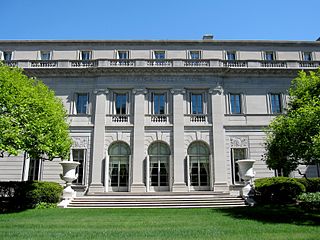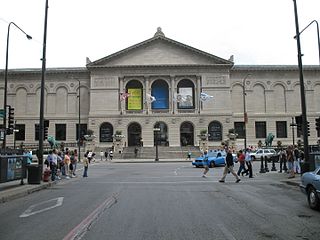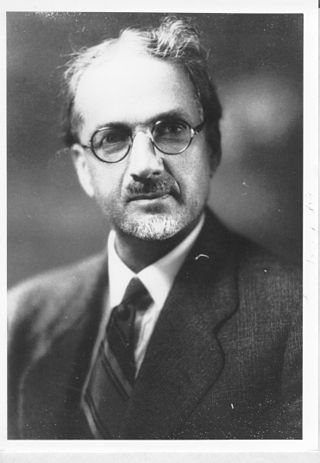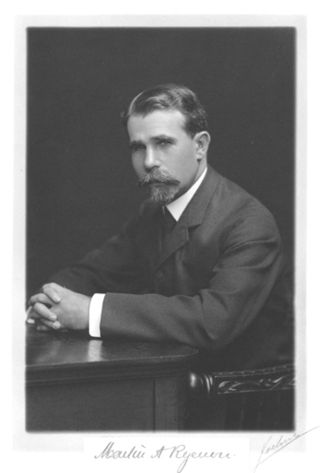
Louis Henry Sullivan was an American architect, and has been called a "father of skyscrapers" and "father of modernism." He was an influential architect of the Chicago School, a mentor to Frank Lloyd Wright, and an inspiration to the Chicago group of architects who have come to be known as the Prairie School. Along with Wright and Henry Hobson Richardson, Sullivan is one of "the recognized trinity of American architecture." The phrase "form follows function" is attributed to him, although the idea was theorised by Viollet le Duc who considered that structure and function in architecture should be the sole determinants of form. In 1944, Sullivan was the second architect to posthumously receive the AIA Gold Medal.

Walter Burley Griffin was an American architect and landscape architect. He is known for designing Canberra, Australia's capital city, the New South Wales towns of Griffith and Leeton, and the Sydney suburb of Castlecrag.

The Folger Shakespeare Library is an independent research library on Capitol Hill in Washington, D.C., United States. It has the world's largest collection of the printed works of William Shakespeare, and is a primary repository for rare materials from the early modern period (1500–1750) in Britain and Europe. The library was established by Henry Clay Folger in association with his wife, Emily Jordan Folger. It opened in 1932, two years after his death.

The Newberry Library is an independent research library, specializing in the humanities and located on Washington Square in Chicago, Illinois. It has been free and open to the public since 1887. Its collections encompass a variety of topics related to the history and cultural production of Western Europe and the Americas over the last six centuries. The Library is named to honor the founding bequest from the estate of philanthropist Walter Loomis Newberry. Core collection strengths support research in several subject areas, including maps, travel, and exploration; music from the Renaissance to the early twentieth century; early contact between Western colonizers and Indigenous peoples in the Western Hemisphere; the personal papers of twentieth-century American journalists; the history of printing; and genealogy and local history.

The Frick Collection is an art museum in New York City. Its permanent collection features Old Master paintings and European fine and decorative arts, including works by Bellini, Fragonard, Goya, Holbein, Rembrandt, Titian, Turner, Velázquez, Vermeer, Thomas Gainsborough, and many others. The museum was founded by the industrialist Henry Clay Frick (1849–1919), and its collection has more than doubled in size since opening to the public in 1935. The Frick also houses the Frick Art Reference Library, a premier art history research center established in 1920 by Helen Clay Frick (1888–1984).

Marion Mahony Griffin was an American architect and artist. She was one of the first licensed female architects in the world, and is considered an original member of the Prairie School. Her work in the United States developed and expanded the American Prairie School, and her work in India and Australia reflected Prairie School ideals of indigenous landscape and materials in the newly formed democracies. The scholar Deborah Wood stated that Griffin "did the drawings people think of when they think of Frank Lloyd Wright ."

The Boston Athenaeum is one of the oldest independent libraries in the United States. It is also one of a number of membership libraries, for which patrons pay a yearly subscription fee to use Athenaeum services. The institution was founded in 1807 by the Anthology Club of Boston, Massachusetts. It is located at 10½ Beacon Street on Beacon Hill.

Richard Stanley Nickel was a Polish American architectural photographer and historical preservationist, who was based in Chicago, Illinois. He is best known for his efforts to preserve and document the buildings of architect Louis Sullivan, and the work of the architecture firm of Adler & Sullivan.

The Granada Theatre was a 3,400–seat movie palace located at 6427-41 North Sheridan Road in the Rogers Park neighborhood of Chicago. It was constructed in 1926 for the Marks Brothers, who were major theatre operators in the U.S. Edward E. Eichenbaum was the principal designer for the architectural firm of Levy & Klein. Eichenbaum also designed the Marbro, Regal, and Century theatres.

The Art Institute of Chicago, founded in 1879, is one of the oldest and largest art museums in the world. It is based in the Art Institute of Chicago Building in Chicago's Grant Park.
Institute of Design (ID) at the Illinois Institute of Technology, founded as the New Bauhaus, is a graduate school teaching systemic, human-centered design.

The Art Institute of Chicago Building houses the Art Institute of Chicago, and is part of the Chicago Landmark Historic Michigan Boulevard District in the Loop community area of Chicago, Illinois. The building is located in Grant Park on the east side of Michigan Avenue, and marks the third address for the Art Institute. The main building was built for the joint purpose of providing an additional facility for the 1893 World's Columbian Exposition, and subsequently the Art Institute. The core of the current complex, located opposite Adams Street, officially opened to the public on December 8, 1893, and was renamed the Allerton Building in 1968.

Albert Henry Krehbiel, was the most decorated American painter ever at the French Academy, winning the Prix De Rome, four gold medals and five cash prizes. He was born in Denmark, Iowa and taught, lived and worked for many years in Chicago. His masterpiece is the programme of eleven decorative wall and two ceiling paintings / murals for the Supreme and Appellate Court Rooms in Springfield, Illinois (1907–1911). Although educated as a realist in Paris, which is reflected in his neoclassical mural works, he is most famously known as an American Impressionist. Later in his career, Krehbiel experimented in a more modernist manner.

The DuPage County Historical Museum, formerly the Adams Memorial Library, is a building designed by Charles Sumner Frost in Wheaton, Illinois, United States.
Patton & Fisher was an architectural firm in Chicago, Illinois. It operated under that name from 1885 to 1899 and later operated under the names Patton, Fisher & Miller (1899–1901) and Patton & Miller (1901–1915). Several of its works are listed on the National Register of Historic Places.

The Champaign Public Library is a library system in Champaign, Illinois. It has two branches: the main library in downtown Champaign and its Douglass branch. With its new location opening on January 6, 2008, the Champaign Public Library almost tripled its square-footage and opened with a collection of almost 285,000 volumes.

Martin A. Ryerson (1856–1932) was an American, lawyer, businessman, philanthropist and art collector. Heir to a considerable fortune, he was a lumber manufacturer and corporate director. He became the richest man in Chicago by the age of 36. A long-time trustee of the University of Chicago, he made large charitable contributions for the construction of buildings on campus. He bequeathed his extensive art collection to the Art Institute of Chicago.

Lauretta Vinciarelli was an artist, architect, and professor of architecture at the collegiate level.
John Vinci is a Chicago-based American architect who works on architectural preservation of historic buildings in addition to new designs.

Robert Burley is a Canadian photographer of architecture and the urban landscape. He is based in Toronto, Canada, and is a Fellow of the Royal Society of Canada.

















